How to Choose a Bike Seat or Saddle
When it comes to comfort on a bike, it doesn’t get more important than your saddle. Sure, tacky grips are nice, and the right pedals make a big difference, but nothing has such a profound and lasting impact on your comfort and enjoyment of the ride as choosing the best bike seat. A good bike saddle is one you don’t notice. A bad one, well, it’s a literal pain in the butt.
The problem is that unlike other components that are easy to compare and choose between, saddles are very personal. What works best for a riding buddy may be untenable for you. There are many factors that come into play when you’re trying to choose a comfortable bike saddle, from width, to shape, to length, to amount of padding, flex and cut-outs. This can make it difficult to know if a saddle will work for you without sitting on it, but with so many options on the market, it’s important to know what ballpark attributes you’re looking for before you go into a bike shop and try sitting on 80 different saddles. So we’ve put together this guide to help you narrow down the field, and figure out what specific features and sizes you should be looking for when picking a bike seat.
How to Measure Your Sit Bone Width
The easiest thing to quantify when shopping for a saddle is your sit bone width. That’s the distance between the two protrusions of your pelvis that make contact with your saddle. A good bike shop will have special tools to measure that width, but if you don’t want to go to a shop you can do it at home. Bike seats and saddles will come in different sizes and shapes built to suit different riders - sit bone width is often used to delineate between sizes.
To measure your sit bone width at home, place a piece of tin foil on a carpeted stair or other surface that is slightly soft, and sit on it, leaning forward to approximate your riding position. Get off and measure the distance between the centers of the two biggest divots in the foil. This number, in millimeters, is your sit bone width.
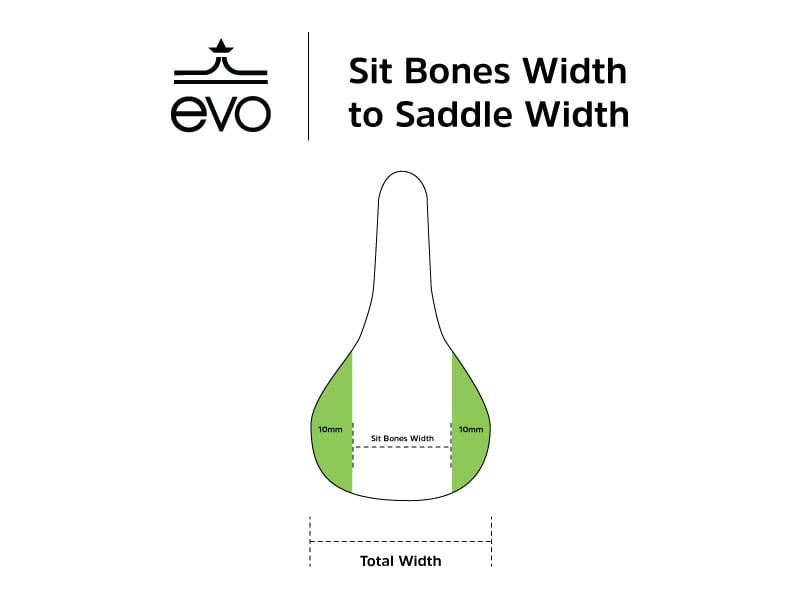
To choose a bike saddle based on your sit bone width, add 20mm to your measurements. Because most saddles round off towards the edge, or are curved from side to side, the usable surface area is a little bit smaller, and they’re built for your sit bones to lie inside from the edge of the saddle.
Another way to approximate your sit bone width is to measure the width of your wrist. WTB has found that for most men, the width of the narrowest part of your wrist, right before the palm, and for women, the widest part, where their wrist bones protrude, is roughly equivalent to the width of their sit bones. So you can just take that measurement with a ruler to get into the ballpark.
No matter how you measure your sit bone width though, remember that number is just a starting point. It helps you figure out approximately what shape saddles you should be trying, but plenty of folks end up on saddles a little outside that measure width, since factors like muscle mass also come into play.
Bike Saddle or Seat Shapes
Once you’ve figured out your sit bone width, it’s time to think about what kind of riding you’ll mostly be doing on this saddle. Your riding style will affect what shape and length saddle will work best.
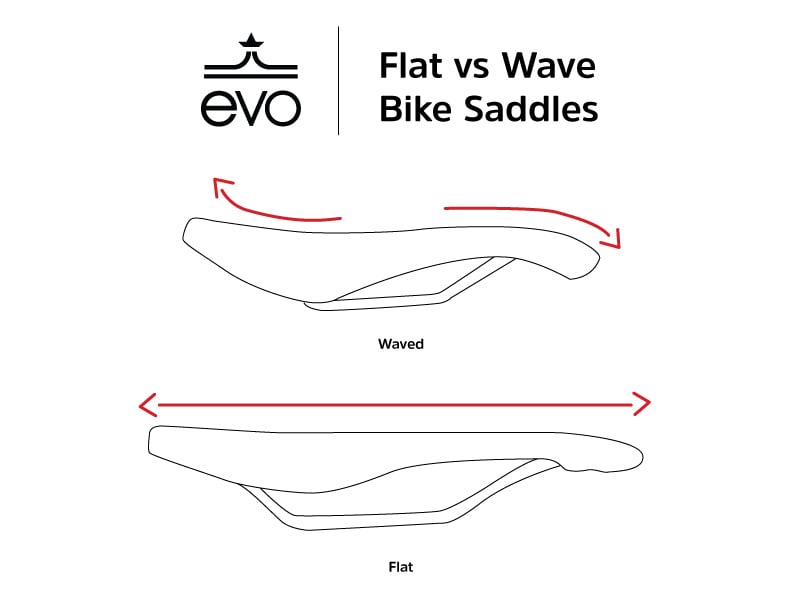
Saddles curve in two directions, both front to back, and side to side, and there are a bunch of different combinations of curves to choose from. The front to back curve is called a saddles “wave.”
Generally, saddles that are more flat front to back, that have less of a “wave” are best for riders who primarily ride in an upright position, but like to be able to slide around on the saddle with multiple comfortable positions. So if most of your time is spent climbing while sitting up, or you ride a drop bar bike and like to slide forward onto the drops, and back onto the hoods, a less waved saddle will be more comfortable.
More waved saddles are designed for folks with a more forward stance (like triathletes) and people with a more upright position who don’t have the flexibility to sit with their hips up on a flatter saddle. More waved saddles have fewer comfortable riding positions, but if you’re generally staying in one position on the saddle, you’ll be fine.
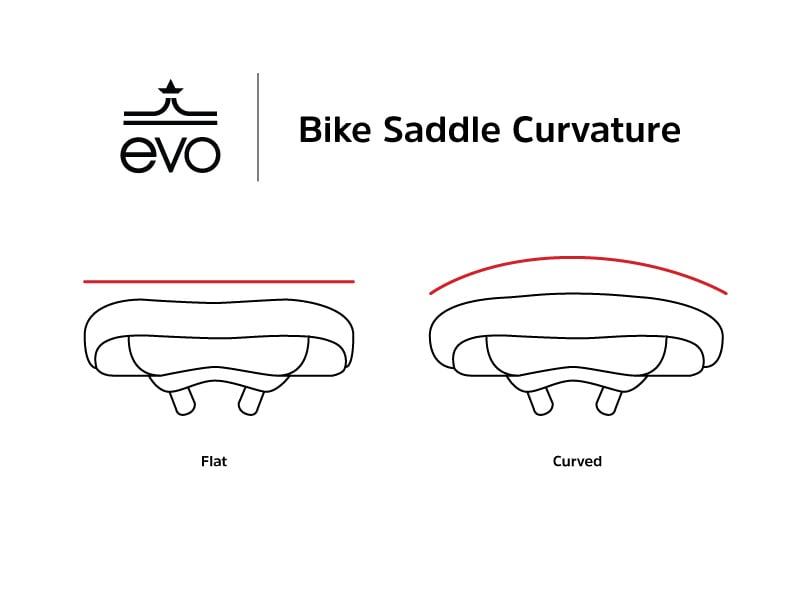
The second direction of curvature is side to side. Generally, flatter saddles are more comfortable, if the saddle isn’t exactly the same width as your sit bones, a flatter saddle will give you more wiggle room to be comfortable on. But a more curved saddle, that fits you well, will keep you centered on the bike and give you a little extra control.
Finally, there’s the shape of the saddle. Looking at your saddle from the top, most saddles are either “T” or “Pear” shaped. “T” saddles have a narrow nose, then flare dramatically at the back. “Pear” saddles flow smoothly from narrow to wide.
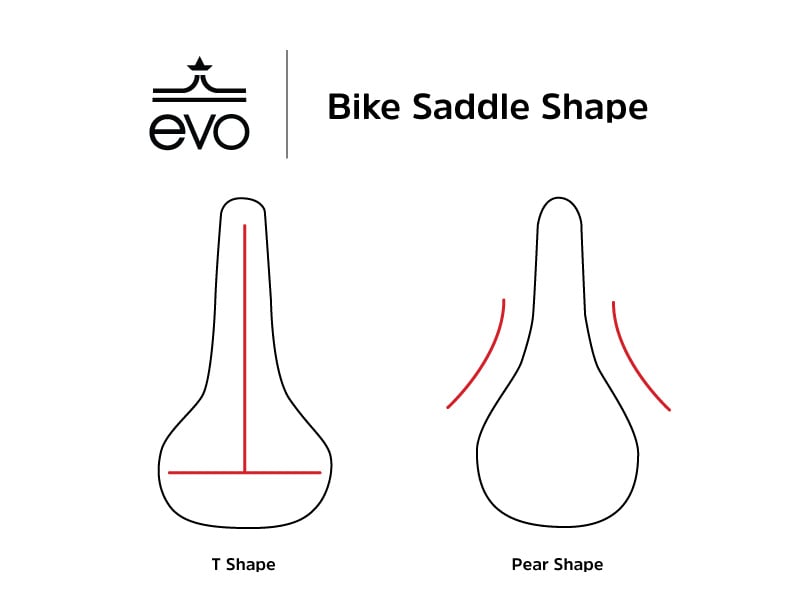
A pear-shaped saddle gives you more room to change riding positions comfortably, but if you sometimes have trouble with thigh rub on your saddle, a T saddle will stay out of the way and help you avoid that.
Finally, a few brands are now coming out with shorter, snub-nosed “power saddles.” These are designed to give you a wider range of riding positions, without the nose of the saddle rubbing or getting in the way as you move around.
Bike Saddle Features
Beyond these basic sizing and shape parameters, brands like to tout special features. Some of these, like gell pads, can make a small difference in comfort for some people, others are just weight saving measures. Here’s a list of the pros and cons of some common features.
For more info, check out our guide on setting your saddle height, position and angle.
Bike Saddle or Seat Padding & Comfort
Often people conflate a saddle’s level of padding with its comfort. That’s actually inaccurate. Sure, padding plays a part, but shape is much more important - a good fitting bike saddle will be more comfortable than a padded bike seat. If you ride in padded bike shorts, remember that they are providing most of the cushion against your saddle, you probably can get away with a less padded saddle. Too much padding will actually lead to chafing and discomfort on longer rides.
If you don’t ride in padded shorts, you need to make sure your saddle fit is perfect. Even then, if you’re riding a hardtail or rigid bike, it’s a good idea to look for something with a little extra padding.
What do Bike Saddle Cutouts Do?
Lots of bike saddles feature some sort of cutout down the middle. These are designed to help with circulation. On longer rides, pressure on your perineum can lead to a loss of circulation to vital parts of your anatomy. However, not all folks benefit from cutouts. If you can sit comfortably on a hard, unpadded seat or bench for longer than five minutes without discomfort, you’ll probably be fine without a channel. However, if you feel any pain or numbness, a saddle with some kind of cutout is a good idea. If you can get away without a cutout, do so, saddles without cutouts are generally more comfortable on longer rides, as long as you’re not having circulation issues.
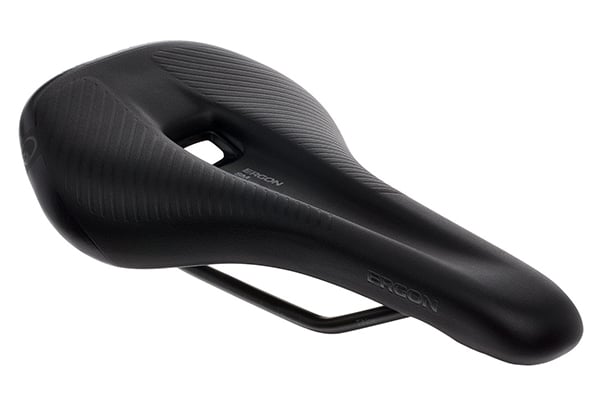
Shock-absorbing Bumpers or “Engineered Flex”
Some brands will build some give into their saddles, either with rubber bumpers or flex zones. If you’re riding a rigid or hardtail bike over rough terrain (especially washboard roads) some kind of flex or shock absorption in the saddle can make a huge difference. However, for mountain bikers, they can make the saddle feel too flexy, and vague.
Non-Slip Bike Saddles
Some saddles have grippy portions built into their covers. These can help you stay situated on the saddle in wet conditions or rough terrain. However, if you like to shift around a lot on the saddle while riding, they can make this hard to do, or uncomfortable. If you like to lock into one position, look for a saddle with rubber grippers, or high-traction materials. Otherwise, it’s very easy to add a little grip tape to a saddle later if you find it’s too slippery.
Gel Padded Bike Seats
Some brands like to hype their “gel comfort pads.” For most serious riders, going on rides longer than half an hour or so, overall saddle shape and fit is much more important than gel padding. So don’t buy into the marketing talk. If a saddle is the right shape for your butt, it will be more comfortable, regardless of what its padding is made of.
Bike Saddle Rail Materials
Saddle rails are usually made of steel, aluminum, titanium or carbon. Many brands will sell the same saddle with different rail materials. When it comes to rail material, the more you pay, the lighter your saddle will be. There’s nothing wrong with aluminum rails on your saddle, but if you’re going for the lightest bike possible, it’s fine to shell out for titanium or carbon too.
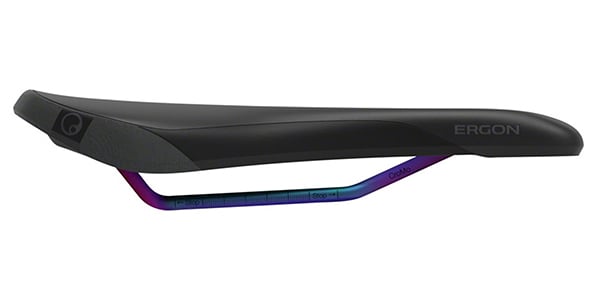
Men’s vs. Women’s Bike Saddles & Seats
Many saddles are gendered, they’re sold as male or female specific. These terms are a little arbitrary, they just mean that a men’s saddle is a little closer to what “average” men are comfortable on, and similarly, women’s saddles are closer to what the brand thinks “average” women want. The problem is that most of us fall somewhere outside of that average anyways.
So don’t be afraid to try saddles designated for folks outside the gender you identify as. The reality is, that different saddle models are designed for different butt shapes, regardless of gender, and there’s nothing wrong with using a saddle that’s branded for a different gender. The most important thing is the comfort of your rear end, not whether the saddle’s packaging is blue or pink.
How to Try out Bike Saddles
Now that you’ve narrowed down what specific attributes you should be looking for in a saddle, it’s time to try a few. If you don’t have a good selection at your local bike shop, it’s easy to order a few online, try them all out in your living room, and return the ones that don’t work for you.
When testing out a bike saddle, it’s key to replicate what it will feel like when riding. So wear your normal riding shorts, and padded shorts if you usually wear them, and try to mimic a riding position on the saddle. Pressure points, and padding that doesn’t work for you will usually become apparent after just a few minutes of sitting on the saddle. If it stays comfortable and you don’t find yourself going numb or aching, you may have found a winner. Just remember, it might be a little intimidating to shop for a new saddle, but it's worth taking your time and finding one that works really well for you.
Learn More With Our Other Bike Guides:
How to Choose a Mountain Bike
Mountain Bike Sizing and Fit Guide
How to Get Started Mountain Biking
How to Choose a Mountain Bike Wheel Size
Mountain Bike Suspension Basics
Women's Mountain Bike Buyer's Guide
How To Get Started Gravel Biking
Electric Mountain Bike Buyer's Guide
Classes of eBikes
Travel Guides - Where to Mountain Bike
Travel Guides - Where to Ride eBikes
Mountain Bike Cockpit Setup & Seat Height
How to Choose a Mountain Bike Dropper Post
How to Choose Mountain Bike Tires
How to Choose Mountain Bike Handlebars
How to Choose Mountain Bike Pedals
How to Choose Clipless Pedals, Shoes & Cleats
How to Choose a Bike Seat / Saddle
Women's Mountain Bike Gear & Clothing Guide
How to Choose MTB Knee Pads
Bike Helmet Size & Fit Guide
How to Choose Bike Shoes
Shimano Groupset Hierarchy Explained
SRAM Groupset Hierarchy Explained
SRAM vs Shimano Groupsets Compared
What to Bring Mountain Biking
What to Wear Mountain Biking
Mountain Bike Tire Pressure Guide
Mountain Bike Maintenance Schedule
How to Clean a Mountain Bike
How to Change Bike Pedals
How to Bleed SRAM Brakes
How to Bleed Shimano Brakes
How to Convert to Tubeless Tires
How to Replace Internal Cable Housing
How to Adjust Your Rear Derailleur
How to Replace a Bike Chain
How to Fix Bike Creaks & Noises